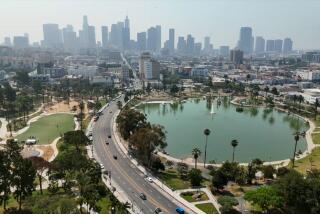District’s sense of security is stolen
- Share via
Wilshire Place is one of those crossroads where old and new Los Angeles meet.
Canopied by a row of old-growth trees, the side street off of Wilshire Boulevard was for decades the route into the landmark Bullocks Wilshire department store, where uniformed valets under a grand portico would greet customers for a day of shopping and later, perhaps, dinner or a drink at the Brown Derby down the street.
Today, the Art-Deco Bullocks building houses a law school, and Wilshire Place is home to a Korean community newspaper as well as shops and restaurants catering to the neighborhood’s mix of law students, office workers, often well-heeled Korean residents and Latino immigrants.
But on Tuesday, thoughts in the neighborhood seemed to dwell on a 17-year-old girl who neither lived nor worked there. Lily Burk was abducted from Wilshire Place on Friday afternoon while running an errand for her mother, a professor at Southwestern Law School. She was killed hours later.
A memorial of flowers and cards on Wilshire Place just north of 7th Street marked the spot where she was allegedly snatched by a 50-year-old transient with a long criminal record.
Burk’s slaying prompted outrage and grief around the city. But for some on Wilshire Place, those emotions were accompanied by fear and a sense that something about their neighborhood might have been permanently lost.
Until a few days ago, Suzan Pour-Sanae, a labor union researcher, loved the area -- the friendly mix of workers, lunches at the law school cafeteria (which used to be Bullocks’ famed tea room) and the throngs of people on the streets. The school bolstered her confidence in the safety of the district.
Now, Pour-Sanae says, she’s afraid to walk alone -- even during the day. She’s planning to buy pepper spray, hoping that might make her feel safe when walking from her car to her office building.
“I guess it was a false sense of security,” she said. “You get used to a neighborhood.”
Emma Lepe, manager at the nearby Coffee Bean & Tea Leaf, said her co-workers had been talking about little else. “I’m pretty sure it could happen again, to anyone.”
Burk’s death comes at a time when L.A. is experiencing its lowest violent crime rate -- including homicides -- in decades. And statistics show that the Wilshire Place neighborhood is far from a hotbed of crime.
The Mid-Wilshire area struggled for decades, culminating in the 1992 riots, when looters ravaged Bullocks Wilshire and other stores. These days the areas is on an upswing, attracting new businesses and residents and even a trendy reputation.
But high-profile crimes can color even the most sturdy districts. In 1988, a 27-year-old graphic artist was killed in gang crossfire in Westwood Village, sparking a decline that persists even today.
But some who live and work near Southwestern Law School said they hope the same fate won’t befall their district, adding that they are optimistic in part because of continuing development in the area and because crime in general seems to be in check.
Leslie Steinberg, who has worked for Southwestern for 28 years, said she -- like so many at the law school--was shaken by Burk’s slaying. But despite that, she still perceives the area as relatively safe and secure.
“I have truly not been worried or aware of anything that would be out of the ordinary from any West L.A. neighborhood,” she said. “That is why something like this, what happened to Lily, is unbelievable.”
With the school on summer break, Steinberg said, only a few people showed up Tuesday for a meeting with a senior LAPD officer to talk about what she called “basic crime prevention.”
The low turnout surprised her a little. But she believes it indicates that members of the Southwestern community “understand that this was a very random crime. There have been a couple of people who have wanted to be reassured.”
Phillip Sanchez hadn’t heard of Lily Burk until he took a walk around his neighborhood Tuesday. As he passed the western entrance to Southwestern’s parking lot -- near where police say Burk was abducted -- he stopped in front of a memorial created with with candles, flowers and a red teddy bear.
“What happened here?” he asked.
When he heard about Burk, his response seemed to focus on the role his neighborhood played in the tragedy.
“I feel shame,” said Sanchez, native of Barcelona, Spain, who has lived off of 7th Street for the last three years. The area, he said, has “Korean shops, Korean news, the university. . . . I never see or hear anything suspicious.”
--
More to Read
Sign up for Essential California
The most important California stories and recommendations in your inbox every morning.
You may occasionally receive promotional content from the Los Angeles Times.










